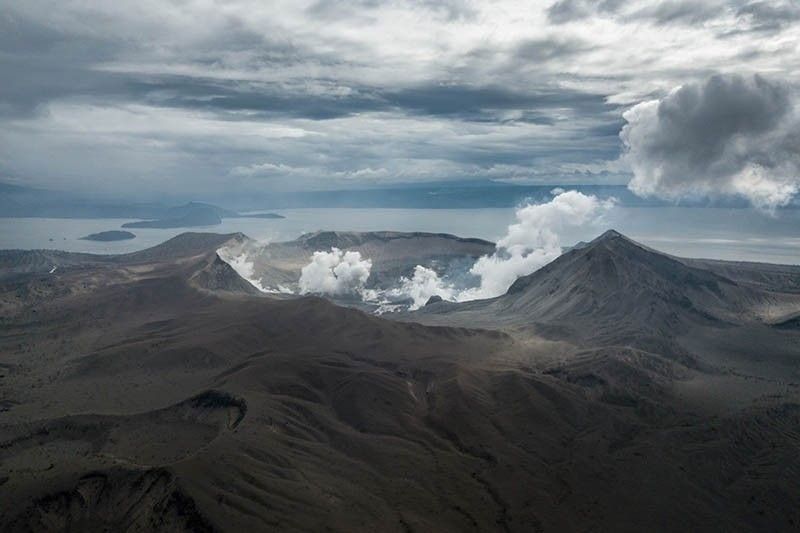Residents given 48 hours to leave Taal danger zone

MANILA, Philippines — Residents still within the 14-kilometer danger zone around Taal Volcano were ordered by the police yesterday to leave within 48 hours or they would be bodily carried out of the area.
Brig. Gen. Bernard Banac, spokesman for the Philippine National Police (PNP), said the ultimatum was issued before the area is placed on total lockdown due to the “deteriorating situation” in the permanent danger zone.
Banac told reporters that the ground in the danger areas identified by the National Disaster Risk Reduction and Management Council (NDRRMC) continued to swell.
Twelve towns and two cities were included in the danger zone due to their proximity to the volcano.
More than 235,000 people have been evacuated, comprising 98 percent of the population in the area.
Interior Secretary Eduardo Año said police officers and soldiers are looking for the remaining two percent of the population around the volcano who refused to heed government’s warning.
Residents who still refuse to leave will be forcibly evacuated, Banac said.
After the 48-hour ultimatum lapses today, Banac said the more than 500 police officers manning checkpoints within the danger zone would be pulled out and relocated outside the volcano’s radius.
They will be positioned in the risk control points beyond the circumferential line.
An official of the Department of the Interior and Local Government (DILG) said they would seek guidance from the NDRRMC regarding the order to shut down commercial establishments in Tagaytay City.
DILG Undersecretary Epimaco Densing III said the order was issued by the department as the supervising authority of local government units.
“We would elevate this to the higher level for them to decide whether or not to allow business establishments in Tagaytay,” he said.
Explosive eruption still possible – Phivolcs
State volcanologists continued to record fewer volcanic earthquakes and smaller amount of sulfur dioxide at Taal Volcano in the past days, but they are not ruling out the probability of an explosive eruption “within hours or days” due to the presence of magma beneath the volcano.
“There is already magma beneath the volcano. We’re looking at how fast the magma could get to the surface (crater),” Science Undersecretary and Philippine Institute of Volcanology and Seismology (Phivolcs) director Renato Solidum Jr. told radio dzMM.
The volcano remains at Alert Level 4 as of yesterday, meaning a hazardous explosive eruption can happen within hours or days.
For the past 24 hours, six volcanic earthquakes were plotted by the Philippine Seismic Network (PSN), registering magnitudes of 1.5 to 2.4.
However, the Taal Volcano Network, which can record small earthquakes undetectable by the PSN, recorded 481 volcanic earthquakes, including eight low frequency tremblers. The volcanic quakes have been linked to the movement of magma.
The amount of sulfur dioxide emitted by the volcano in the past 24 hours was 153 tons, lower than the normal level of 500 tons a day.
No ash emission was observed around Taal Volcano yesterday.
“However, unconsolidated ash blanketing the volcano has been remobilized and transported by strong low-level winds toward southwest, affecting towns of Lemery and Agoncillo,” Phivolcs said in an advisory.
It said several airlines reported that “remobilized” volcanic ash reached a height of approximately 5,800 meters or 19,000 feet.
Mariton Bornas, chief of the Phivolcs Volcano Monitoring and Eruption Prediction Division, said people living near the volcano should not be complacent despite the significant decline in Taal’s activity.
She said the lower sulfur dioxide might also mean that the vents are temporarily blocked.
If the lower parameters continue for two weeks, Bornas said the agency may lower Taal’s alert status from 4 to 3.
“But not all can return to their homes. We will not recommend that,” Bornas said.
Phivolcs has recommended the permanent relocation of people living on Volcano Island, which is identified as a permanent danger zone. Around 6,000 to 10,000 people reside on the island.
Recent aerial surveys showed that new cracks have appeared on the ground due to continued quakes and intrusion of magma, Bornas said.
“There is what we think is a new cone that has been created by lava fountaining events after the main (eruption) phase,” she said, referring to Taal’s magmatic eruption on Jan. 12, which covered various areas in Southern Tagalog region with ash and mud.
Two road sections in Batangas remain closed, according to the Department of Public Works and Highways (DPWH).
The DPWH said the Tanauan-Talisay-Tagaytay Road and Talisay-Laurel-Agoncillo Road are still on lockdown.
“As a safety precaution, clearing of ashfall and pruning of trees along the roads are being implemented outside the 14-kilometer danger zone while clearing operations in areas within the danger zone were suspended,” DPWH said. – With Helen Flores, Jose Rodel Clapano
- Latest
- Trending



























